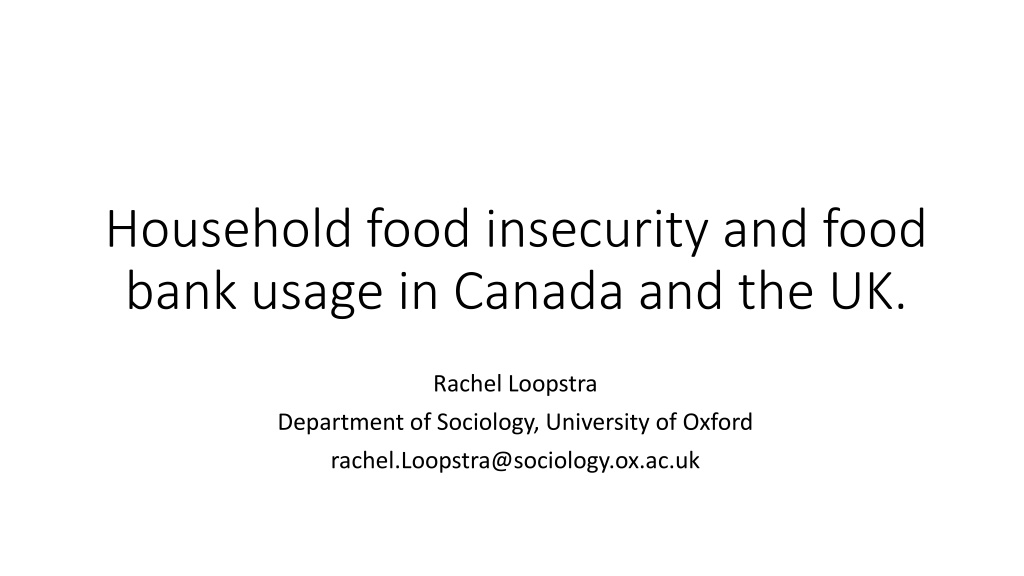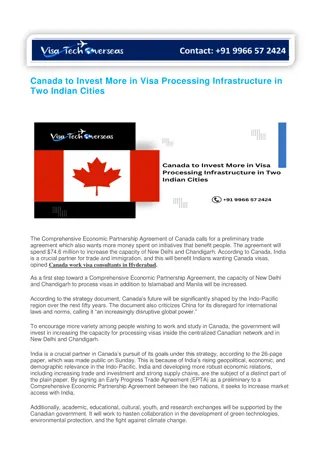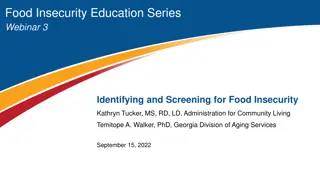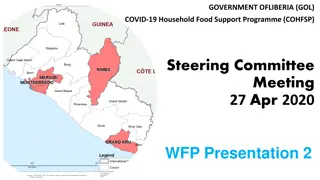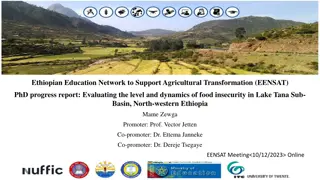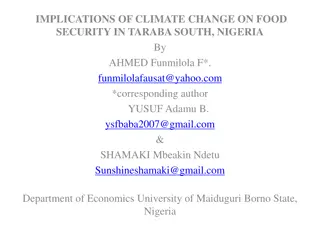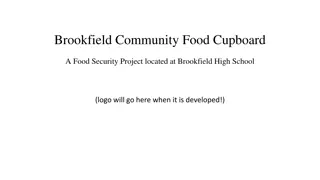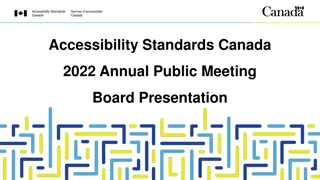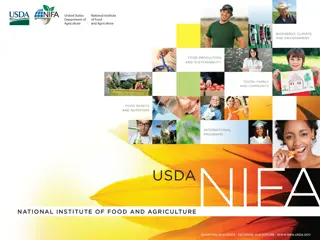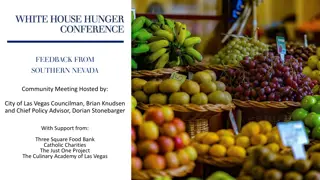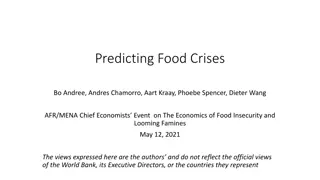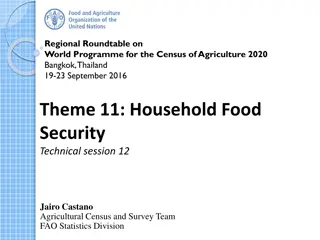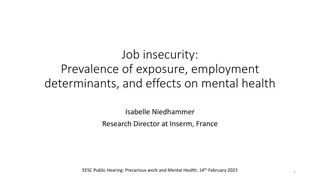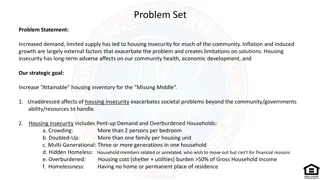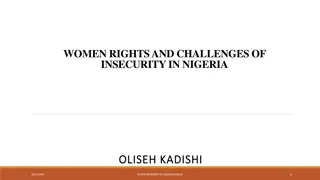Household Food Insecurity in Canada and the UK: A Study
This study explores household food insecurity and food bank usage in Canada and the UK, shedding light on the initiation of food banks, trends in food bank use, and the demographics of individuals relying on food banks. It delves into the construct of food insecurity, potential manifestations, and the Household Food Security Survey Module to understand the challenges faced by individuals with uncertain access to food. The research highlights the alarming rates of food insecurity and the societal factors contributing to this issue.
Download Presentation

Please find below an Image/Link to download the presentation.
The content on the website is provided AS IS for your information and personal use only. It may not be sold, licensed, or shared on other websites without obtaining consent from the author.If you encounter any issues during the download, it is possible that the publisher has removed the file from their server.
You are allowed to download the files provided on this website for personal or commercial use, subject to the condition that they are used lawfully. All files are the property of their respective owners.
The content on the website is provided AS IS for your information and personal use only. It may not be sold, licensed, or shared on other websites without obtaining consent from the author.
E N D
Presentation Transcript
Household food insecurity and food bank usage in Canada and the UK. Rachel Loopstra Department of Sociology, University of Oxford rachel.Loopstra@sociology.ox.ac.uk
The first food bank was initiated in Canada in 1981 at a time of recession and erosion of social security.
Lines of people lining up for food raised alarm: people are hungry in Canada.
More than 800 food banks operating a total of 3000 food programs. Food Banks Canada
What we have learned from food bank data
Trends in food bank use over time. (Food Banks Canada, HungerCount, 2014)
Who uses food banks in Canada? Most supported by state-benefits: Long-term unemployed People with disability Newly unemployed Most live in rental housing. High proportion of Aboriginal people and immigrants or refugees. (Food Banks Canada, HungerCount, 2014)
Wider view: household food insecurity data
Household Food Insecurity Construct Food insecurity: uncertain and insufficient access to food arising from resource constraint Potential Manifestations* Reduced food intake Stress, worry & anxiety Reduced quality of food intake Social exclusion Hunger * vary in severity and duration
Household Food Security Survey Module Series of questions referencing past 12 months and that specify lack of money: Worried that food is going to run out Food didn't last and there wasn't any money to get more Couldn't afford to eat balanced meals Cut size of meals or skipped meals Ate less than you felt you should Were ever hungry but did not eat Lost weight Did not eat for whole day Marginal Moderate Severe Note: Consistent with Household Food Security Survey Module used in USA.
Measurement and monitoring in Canada Regularly included on nationally representative health survey since 2004 Comparable samples available in most provinces since 2007
Over 12% of Canadians live in food insecure households and problem worsening. (Tarasuk et al. PROOF. 2014)
Characteristics associated with vulnerability Declining household income Reliance on government support Rental accommodation Single adult households, with or without children Aboriginal status Chronic health conditions (Tarasuk, Mitchell, Dachner, 2013.)
Characteristics associated with vulnerability highlight the importance of: INCOME Persistent poverty Security of incomes Importance of savings and wealth to buffer income shocks Variation in household costs (e.g. medical expenses, area- variation in cost of living, rent)
Distribution of Canadian households by main source of income: Food Secure Food Insecure
Do food bank statistics give us an accurate picture of vulnerability in the population?
Food bank statistics obscure level of need in the population. 5000000 4000000 4.6X Difference 3000000 Number of Persons 2000000 1000000 0 Total Assisted Total Food Insecure Children Assisted Food Insecure Children 2011 (Loopstra & Tarasuk, Society and Social Policy. 2015)
Differences vary across provinces and over time Ontario Nova Scotia 1,600,000 180,000 3.5-4X gap 7X gap 160,000 1,400,000 140,000 1,200,000 120,000 1,000,000 100,000 Food Bank Users 800,000 80,000 Food Insecure 600,000 60,000 400,000 40,000 20,000 200,000 0 0 2007 2008 2009 2010 2011 2007 2008 2009 2010 2011
Food bank statistics obscure where burden of problem lies. Main Source of Household Income 70% 60% Social Assistance Employment 50% 40% 30% 20% Employment Social Assistance 10% 0% Households using Food Banks (n=349842) Food Insecure Households (n=1592400) Data Sources: Food Banks Canada Hunger Count, 2011; Canadian Community Health Survey, 2011.
Food bank users are subset of food insecure households in most severe circumstances. Food Insecurity Status of Food Bank Users (n=101) Food Secure Marginal Moderate Severe Study of low income families in Toronto.
Food bank users are subset of food insecure households in most severe circumstances. Families Using Food Banks (n=84) All Food Insecure Families in Sample (n=283) n 123 4 42 114 Highest Level of Employment % n % No Job 43.5 1.4 14.8 40.3 52 2 15 15 61.9 2.4 17.9 17.9 Occasional Part-time Fulltime Largest % of income from: Unemployment/Workers Comp 5 1.8 51.2 6.4 8.5 30.7 1.4 IQR 2 24 5 8 44 1 2.4 28.6 6.0 9.5 52.4 1.2 IQR Employment Disasbility 145 18 24 87 4 Other Welfare Seniors' pension Income as a % of Low Income Cut-Off Median 61.2 Median 52.8 (48.8-77.9) (43.6-63.3) Study of low income families in Toronto.
Likelihood of using a food bank rises with severity of food Figure: Proportion of families who used a food bank in the past 12 months, by household food security status: insecurity. 100 90 80 % of food security category 70 60 50 Used a Food Bank 40 Did Not Use a Food Bank 30 20 10 0 Food Secure Marginal Moderate Severe Baseline sample: n=485
Why the disconnect? Who perceives food banks as an option for help Level of need, real and perceived (Loopstra & Tarasuk, 2012) I wasn t desperate enough to use a food bank. That would be a last resort. [Food banks] are for homeless people Inability to use food banks Limited operating hours difficult for employed households to access Food bank closure, unable to reach Turned away because not enough food Who food banks are informally promoted to Referrals from social workers Eligibility criteria related to income cut-offs, employment No restrictions for individuals on social assistance
Food banks across Canada have limited capacity. Victoria 58.6% Edmonton 66.2% Toronto 77.9% Quebec City 67.8% Halifax 83.9% All Clients need more food than food bank is able to provide. Agency would expand food program if more resources were available Agency sometimes cut the size of the hampers provided because of insufficient food Agency sometimes took additional measures to restrict access* 71.8% 58.6% 48.5% 74.6% 55.6% 71.0% 62.7% 6.9% 23.5% 52.5% 47.8% 48.4% 41.2% 13.8% 14.7% 35.3% 31.1% 25.8% 27.4% aThe additional measures assessed included prioritizing who to serve, reducing the hours of service, and turning people away because the agency had insufficient food to meet demands. (Tarasuk et al. BMC Public Health. 2014.)
Figure: Drivers of overlap between food insecurity and food bank use. Food Insecure Perceived need Stigma Quantity and quality of food Lack of accessibility Desperation Referral Real and perceived eligibility Food bank accessibility and capacity Food Bank Users
Daily Mail, April 2012 Staggering rise of the British food bank: One opens every week after rise in families unable to afford to eat. Trussell Trust, 16 April 2014 Latest foodbank figures top 900, 000
Reasons for referral to Trussell Trust Foodbanks (Perry, Jane et al. Emergency Use Only: Understanding and reducing the use of food banks in the UK. 2014.)
Interviews with local authority staff highlighting links between cuts and food bank referrals. We ve faced very substantial reductions in our funding what we used to do was work a different scheme, which was funded through grant funding so we were trying to think of creative ways in which we could continue to support families... so we gave [distributing food bank vouchers] a try. Excerpt from interview with a local authority family support team worker; Lambie-Mumford, J Social Policy, 2013
Other Views "Food from a food bank the supply is a free good, and by definition there is an almost infinite demand for a free good." - Lord Freud, Parliamentary Under Secretary of State, Minister for Welfare Reform no robust evidence linking food bank usage to welfare reform - Esther McVey, Minister of State for Employment, Letter to Scottish Government, June 2014
Research Questions Has the initiation of food banks across the UK related to local area socioeconomic conditions, budget cuts, and welfare sanctions? Is there evidence that these factors are driving more people to use food banks where they open?
Local authority data from 375 Local authorities in England, Scotland, Wales Gross Value Added Subregional measure of economic production Unemployment Annual cut in local authority spending per capita Social care, housing, community etc. Annual cut in central welfare benefit spending per capita Jobseeker s Allowance, Housing Benefit, Pension Credit etc. Rate of adverse sanctions applied to Jobseeker s Claimants Proportion of local area population identifying as Christian
Analysis 1: Food bank initiation Cross-local authority logistic regression model examining potential drivers of first food bank initiation in 375 local authorities after 2009 to 2013. Local authority-years excluded from analysis after censoring. N=1071 local-authority years included. Clustered standard errors by local authority
The expansion of food banks across local authorities in the UK 2009 2013 Trussell Trust food banks in 29 local authorities Trussell Trust food banks in 251 local authorities (Loopstra et al. BMJ. 2015)
Analysis 2: Density of food parcel distribution Cross-local linear regression model examining potential drivers of food parcel distribution in local authority-years when food banks were operating over 2010 to 2013. N=575 local authority-years included. Clustered standard errors by local authority Control for food bank operations Duration Number of operational food banks
Where have food banks opened? Local Authority Spending The odds of a first food bank opening rose with: Unemployment Magnitude of cut to local authority spending Magnitude of cut to central welfare benefit spending .4 Probability of a Food Bank .3 .2 .1 0 4 8 12 16 Percentage Cut in Local Authority Spending in Previous Year (Loopstra et al. BMJ. 2015)
Food Parcel Distribution as Percent of Population in Local Authorities with Foodbanks. 4.5 4 3.5 Percent of Local Authority Population 3 2.5 2 1.5 1 0.5 0 2006 2007 2008 2009 2010 2011 2012 2013 (Loopstra et al. BMJ. 2015)
Where are more people using food banks? Jobseeker s Allowance Sanctioning Cuts in Central Benefit Spending 2.5 Estimated Prevalence of Food Parcel Distribution, % 1.8 Estimated Prevalence of Food Parcel Distribution, % 1.6 2 1.4 1.5 1.2 1 1 .5 1 1.5 2 2.5 3 2 4 6 8 10 Percent Cut in Central Benefit Spending Percentage of JSA Claimants Sanctioned (Loopstra et al. BMJ. 2015)
Role of supply-side: obscure need? But food bank operations also influence level of food parcel distribution: Where more food banks available Where food banks established for longer If food banks not as available, can reduce accessibility and obscure wider need in communities. Referral system must link welfare reforms and unemployment with food bank use. Outstanding question: how many people are food insecure in the UK and vulnerability among groups not gaining/seeking referrals? (Loopstra et al. BMJ. 2015)
Conclusions Link between food bank initiation and use to indicators of economic hardship suggest food bank data are indicative of rising levels of need. Yet, lack of accessibility and use of food banks could be obscuring true level of need in population arising from these factors, and referral system may obscure other vulnerable groups in the population. (Loopstra et al. BMJ. 2015)
Moving forward on food insecurity research in UK Monitoring of food insecurity needed to understand the magnitude of the problem, severity, trends over time, and vulnerability. Food bank use indicates vulnerability connected to inadequacy of welfare system. Less known about: Vulnerability linked to insecure employment, insufficient wages, and underemployment. Vulnerability arising from costs of living: Areas of greater hardship related to costs of acquiring food, rent Household-arrangement specific: childcare costs, health conditions
Understanding prevention and intervention Does availability of food aid reduce household food insecurity? Security that food will always be available? Unlikely, given inherent limitations of system: restricted use and provision, reliance on volunteers/charity Sufficient to ensure food needs are met? What forms of social security ensure households are protected from income shocks? What regulations are needed to ensure security and adequacy of earned incomes? Food Insecurity Status of Food Bank Users (n=101) Food Secure Marginal Moderate Severe
Thank you Acknowledgements: Valerie Tarasuk, Professor, University of Toronto, & PROOF research team. Aaron Reeves, David Taylor-Robinson, Ben Barr, Martin McKee, David Stuckler http://nutritionalsciences.lamp.utoronto.ca/
